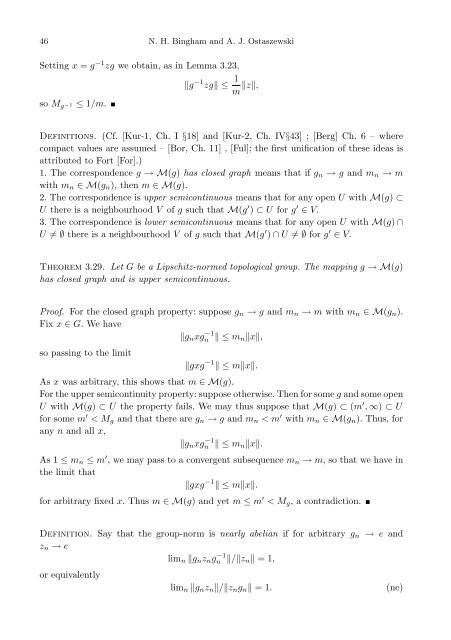Normed versus topological groups: Dichotomy and duality
Normed versus topological groups: Dichotomy and duality
Normed versus topological groups: Dichotomy and duality
Create successful ePaper yourself
Turn your PDF publications into a flip-book with our unique Google optimized e-Paper software.
46 N. H. Bingham <strong>and</strong> A. J. OstaszewskiSetting x = g −1 zg we obtain, as in Lemma 3.23,‖g −1 zg‖ ≤ 1 m ‖z‖,so M g −1 ≤ 1/m.Definitions. (Cf. [Kur-1, Ch. I §18] <strong>and</strong> [Kur-2, Ch. IV§43] ; [Berg] Ch. 6 – wherecompact values are assumed – [Bor, Ch. 11] , [Ful]; the first unification of these ideas isattributed to Fort [For].)1. The correspondence g → M(g) has closed graph means that if g n → g <strong>and</strong> m n → mwith m n ∈ M(g n ), then m ∈ M(g).2. The correspondence is upper semicontinuous means that for any open U with M(g) ⊂U there is a neighbourhood V of g such that M(g ′ ) ⊂ U for g ′ ∈ V.3. The correspondence is lower semicontinuous means that for any open U with M(g) ∩U ≠ ∅ there is a neighbourhood V of g such that M(g ′ ) ∩ U ≠ ∅ for g ′ ∈ V.Theorem 3.29. Let G be a Lipschitz-normed <strong>topological</strong> group. The mapping g → M(g)has closed graph <strong>and</strong> is upper semicontinuous.Proof. For the closed graph property: suppose g n → g <strong>and</strong> m n → m with m n ∈ M(g n ).Fix x ∈ G. We have‖g n xgn−1 ‖ ≤ m n ‖x‖,so passing to the limit‖gxg −1 ‖ ≤ m‖x‖.As x was arbitrary, this shows that m ∈ M(g).For the upper semicontinuity property: suppose otherwise. Then for some g <strong>and</strong> some openU with M(g) ⊂ U the property fails. We may thus suppose that M(g) ⊂ (m ′ , ∞) ⊂ Ufor some m ′ < M g <strong>and</strong> that there are g n → g <strong>and</strong> m n < m ′ with m n ∈ M(g n ). Thus, forany n <strong>and</strong> all x,‖g n xgn−1 ‖ ≤ m n ‖x‖.As 1 ≤ m n ≤ m ′ , we may pass to a convergent subsequence m n → m, so that we have inthe limit that‖gxg −1 ‖ ≤ m‖x‖.for arbitrary fixed x. Thus m ∈ M(g) <strong>and</strong> yet m ≤ m ′ < M g , a contradiction.Definition. Say that the group-norm is nearly abelian if for arbitrary g nz n → elim n ‖g n z n gn −1 ‖/‖z n ‖ = 1,or equivalentlylim n ‖g n z n ‖/‖z n g n ‖ = 1.→ e <strong>and</strong>(ne)
















